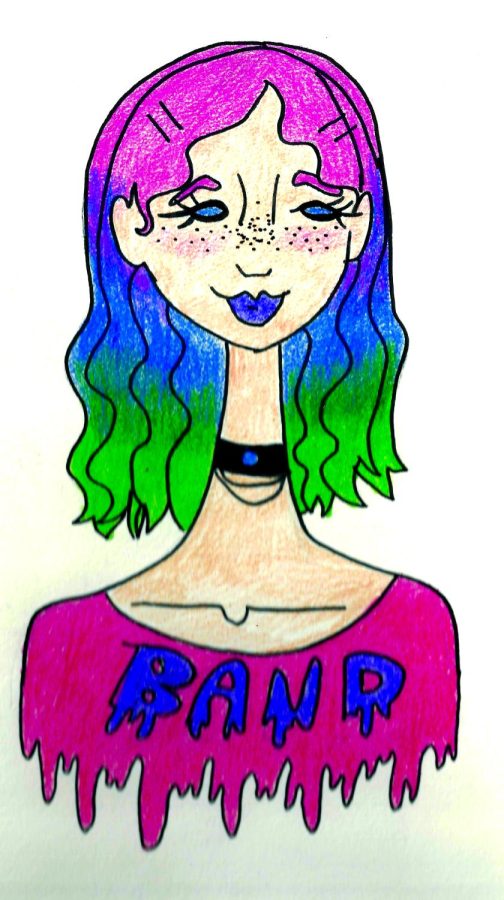‘Scott Pilgrim vs. the World’ vs. the Manic Pixie Dream Girl
January 23, 2019
“Scott Pilgrim vs. the World” is a rollercoaster of a movie. A yeti and twin dragons made out of musical energy face off, a sorcerer shoots fireballs while surrounded by “demon hipster chicks,” one of the villains orgasms into an explosion of coins. It’s great.
The plot in a nutshell revolves around 22-year-old Scott Pilgrim pursuing a relationship with mysterious 23-year-old Ramona Flowers. To do so, Scott has to defeat the League of Evil Exes — a collective of seven people Ramona has dated since middle school who seek to control her love life after feeling wronged by her breaking up with them. Along the way, Scott learns more about himself, ultimately emerging from the conflicts victorious and changed for the better.
The overall narrative might seem rather familiar and that’s because the skeleton of the plot basically adds up to a man bettering himself within the pursuit of an interesting woman.
It’s a storyline we’ve seen hundreds, if not thousands of times, and it’s led to the identification of a pervasive trope in media: the Manic Pixie Dream Girl.
The term “Manic Pixie Dream Girl” was coined in 2005 by film critic Nathan Rabin. The trope itself refers to a quirky, whimsical woman who teaches a story’s protagonist — usually a straight white man depicted as some kind of uptight yet lovable jerk — to embrace the wonders of life.
Her sole purpose is to help the protagonist as she pursues none of her own interests. She only exists to hold the main character’s hand and guide him toward being a better person.
Not surprisingly, a lot of straight white men buy into the trope. They buy into “Scott Pilgrim vs. the World” for the same reason. They see the adventure, they see a cool and mysterious girl, they see themselves represented on screen. They see Scott in pursuit of Manic Pixie Dream Girl Ramona.
But that’s not what the movie is about, even if the protagonist himself thinks that’s what’s happening. Scott Pilgrim is not a lovable jerk, and Ramona Flowers is not a Manic Pixie Dream Girl.
At the start of the movie, Scott is not a good person. Before we even meet him, the narrator tells us this movie’s protagonist is dating a high schooler. The minute we actually see Scott, talking to the members of his band around a kitchen table, one of the first things he does is fetishize the fact that his underage girlfriend Knives Chau is Chinese. He even admits a short time later that he’s dating Knives just because it’s “simple” and because he just wants the satisfaction of someone fawning over him, though the latter is much more shown than it is told. He has very little in the way of redeeming qualities.
Ramona is on the opposite side of the spectrum as the imagined positive traits aren’t there. She may have pink hair and she may do quirky things like roller skate everywhere, but she isn’t a selfless, spotless girl with a lust for life. She has flaws: She’s apathetic, sometimes inconsiderate and dating Scott even though she’s not ready for another relationship. Her character flaws are important because an actual Manic Pixie Dream Girl has none. Flaws make a character more relatable, and there’s nothing to relate to in that trope.
Ramona Flowers is as much a victim of her evil exes’ harassment as she is a victim of false expectations. When Scott first meets her at a party, various side characters tell him that she’s “hardcore,” she “kicks all kinds of ass,” and she’s “got some battle scars.” None of those people actually know Ramona, yet each person is either revering her or writing her off.
Those side characters, Scott’s naive willingness to buy into their claims and Ramona herself are all a commentary on the Manic Pixie Dream Girl trope. A perfect example comes when Scott refers to Ramona as “fickle, impulsive, spontaneous” after a scene where he finds she has dyed her hair from pink to blue. There’s no spontaneity there, however, as Ramona literally tells him in the scene right before that she changes her hair every week-and-a-half. Even when she explicitly states a rather underwhelming fact about herself, people like Scott mysticize and misrepresent her.
So if Ramona won’t guide Scott towards redemption and personal growth, who will? Well, that’s up to Scott himself. In the final battle, Scott fights the main villain Gideon Graves for Ramona and pulls a sword out of his own chest (please, watch the movie), a flaming pink katana aptly named the Power of Love.
However, he is quickly killed. After cashing in an extra life he earned earlier (PLEASE, watch the movie), Scott gets a do-over for the final battle. This time, he states he wants to fight Gideon for himself and pulls out a different sword, a flaming purple katana named the Power of Self-Respect. It’s through this newfound growth and some aid from Knives’ fighting skills that Scott finally defeats the seventh and last of Ramona’s evil exes.
While literally sword-fighting with a weapon made out of self-respect is a pretty unmistakable metaphor, the build-up to Scott’s growth is rather spread out. When first faced with the idea he’ll have to defend his life against seven high-energy, superpowered psychopaths, he more or less naively accepts it without much fuss. It’s not even until after he defeats Ramona’s third evil ex that he angrily starts to question whether or not the struggle is worth it.
It’s not until Scott acknowledges his flaws and makes amends with the people he’s wronged that he finally has the means to grow. By the end of the movie, Scott has his own relationship with the League of Evil Exes. They’re no longer obstacles to Ramona’s love, they’re a realization of his toxic traits.
When Scott defeats Gideon, he is faced with one final challenge – a dark version of himself called Nega-Scott. But by the time Nega-Scott appears, Scott has already made peace with himself, and the two Scotts simply talk things out offscreen and agree to meet later for coffee. It’s played for comedy in the movie, but it’s a clever depiction of our protagonist’s development.
In “Scott Pilgrim vs. the World,” a man does in fact better himself within the pursuit of an interesting woman. But she doesn’t lead him through his growth, and he isn’t some aimless man in need of just one person to show him the light. Ramona Flowers does not deserve to be put into the same category as characters like Claire Colburn from “Elizabethtown” or Margo Roth Spiegelman from “Paper Towns.” Her character has her own ambitions, her own wants and her own flaws.
As much as a lot of the movie’s fans might hate to admit, Scott is the only one responsible for his personal growth. Ramona is not there to guide Scott towards his own destiny; she has better things to do.
Aaron Hluch is an entertainment writer. Contact him at [email protected].

























